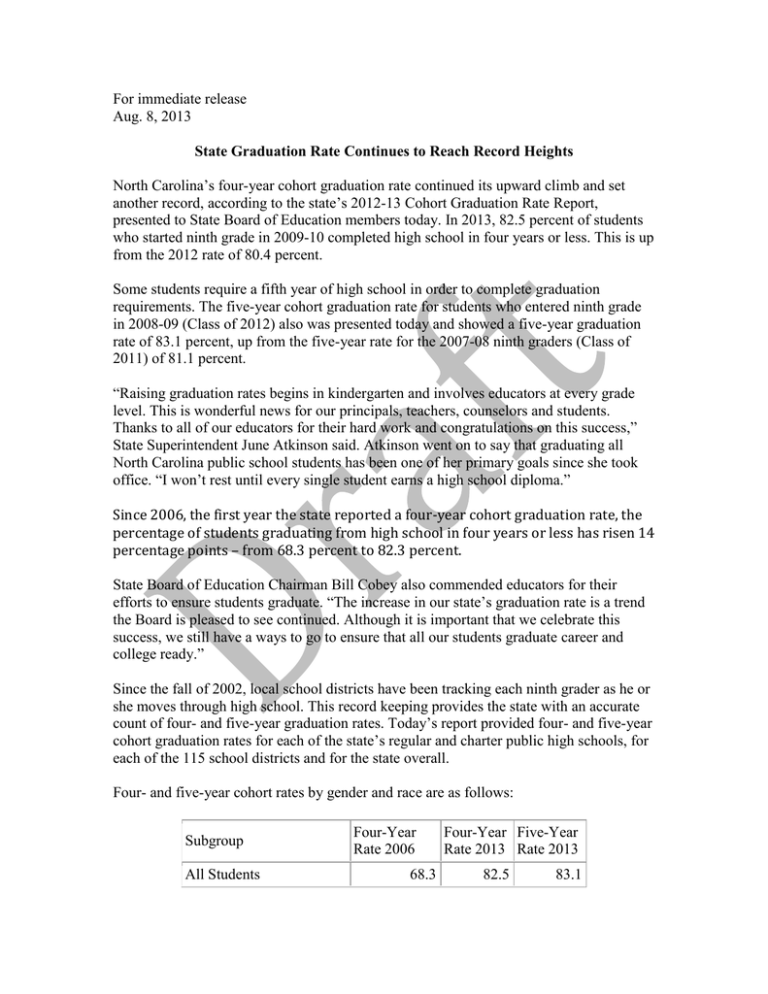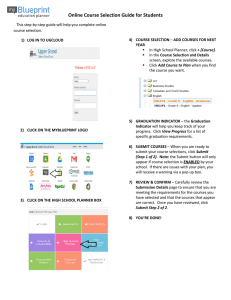For immediate release Aug. 8, 2013
advertisement

For immediate release Aug. 8, 2013 State Graduation Rate Continues to Reach Record Heights North Carolina’s four-year cohort graduation rate continued its upward climb and set another record, according to the state’s 2012-13 Cohort Graduation Rate Report, presented to State Board of Education members today. In 2013, 82.5 percent of students who started ninth grade in 2009-10 completed high school in four years or less. This is up from the 2012 rate of 80.4 percent. Some students require a fifth year of high school in order to complete graduation requirements. The five-year cohort graduation rate for students who entered ninth grade in 2008-09 (Class of 2012) also was presented today and showed a five-year graduation rate of 83.1 percent, up from the five-year rate for the 2007-08 ninth graders (Class of 2011) of 81.1 percent. “Raising graduation rates begins in kindergarten and involves educators at every grade level. This is wonderful news for our principals, teachers, counselors and students. Thanks to all of our educators for their hard work and congratulations on this success,” State Superintendent June Atkinson said. Atkinson went on to say that graduating all North Carolina public school students has been one of her primary goals since she took office. “I won’t rest until every single student earns a high school diploma.” Since 2006, the first year the state reported a four-year cohort graduation rate, the percentage of students graduating from high school in four years or less has risen 14 percentage points – from 68.3 percent to 82.3 percent. State Board of Education Chairman Bill Cobey also commended educators for their efforts to ensure students graduate. “The increase in our state’s graduation rate is a trend the Board is pleased to see continued. Although it is important that we celebrate this success, we still have a ways to go to ensure that all our students graduate career and college ready.” Since the fall of 2002, local school districts have been tracking each ninth grader as he or she moves through high school. This record keeping provides the state with an accurate count of four- and five-year graduation rates. Today’s report provided four- and five-year cohort graduation rates for each of the state’s regular and charter public high schools, for each of the 115 school districts and for the state overall. Four- and five-year cohort rates by gender and race are as follows: Subgroup All Students Four-Year Rate 2006 68.3 Four-Year Five-Year Rate 2013 Rate 2013 82.5 83.1 Male 64.0 78.6 79.9 Female 72.6 86.6 86.5 American Indian 51.1 77.3 76.2 Asian 75.2 89.9 90.2 Black 60.4 77.5 78.7 Hispanic 52.3 75.3 77.6 Two or More Races 66.0 81.5 83.1 White 73.5 86.2 86.3 Economically Disadvantaged 55.6 76.1 78.9 Limited English Proficient 55.0 48.8 58.2 Students With Disabilities 50.0 62.3 65.5 Not Available >95 Not Available Academically Gifted This is the first year a four-year cohort graduation rate was reported for Academically and Intellectually Gifted (AIG) students due to the addition of the AIG subgroup to the state accountability reporting system. “It is just as important we track the academic success of these students as we do our other subgroups as their success will help us achieve a 100 percent graduation rate,” Atkinson said. The rules for calculating graduation rates meet federal requirements and the National Governor’s Association’s definition. In North Carolina, students who leave high school for a community college GED or adult high school program are counted as dropouts under state policy. In addition, school officials only identify a student as a transfer to another high school when the receiving school requests the student’s records. If the transfer is not confirmed, the student is counted as a dropout. North Carolina has a number of efforts underway to help strengthen the high school experience and ensure its relevancy for all students. These efforts include the Early College High School initiative, which provides students with the opportunity to pursue a rigorous five-year high school curriculum in which they can earn both a high school diploma and an associate’s degree or two years of college credit. The North Carolina New Schools Project helps foster high schools that are designed to be more focused and rigorous in smaller learning communities for students and teachers. In addition to its intensive assistance to low-performing schools, the North Carolina Department of Public Instruction is developing software that will allow schools to identify students most at risk of dropping out so that educators can effectively address the academic needs of those students in a more focused way. Students also are encouraged to explore Career and Technical Education (CTE) courses. Eighty percent of students who are CTE completers say that the availability of these courses was one of the main reasons they stayed in school. Local districts also employ ninth grade academies, career counseling and course credit recovery programs as measures to keep students in school through graduation. The full report on the state’s cohort graduation rate, as well as previous years’ reports, is available online at www.ncpublicschools.org/accountability/reporting/cohortgradrate.




